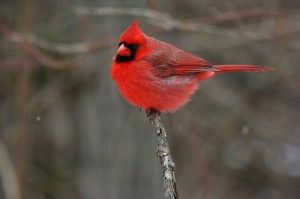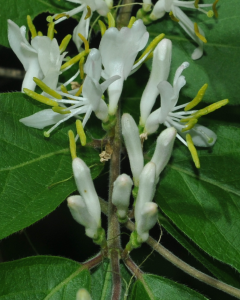
The northern cardinal adapts well to urban environments. Photo: Dominic Sherony
The make up of urban landscapes may throw a curve ball at female northern cardinals looking for a mate with more than just a great personality.
Male cardinals flaunt their stuff through ornamentation, physical aspects like their coloration. But a recent study suggests that in urban areas, where invasive plants like the Amur honeysuckle are widespread, their color might not be as good an indicator of the 9-inch songbird’s physical prowess.
From 2006 to 2008 researchers measured and collected feathers from 129 males and 145 females in 13 forests in central Ohio. They compared the colors of the feathers to the bird’s size and mass to see if the bird’s location — in a more urban or rural setting — affected feather coloration.
The way nature worked it out, the redder the male cardinal, often, the better condition it’s in. And fitter males make more ideal mates.
But the study in The Wilson Journal of Ornithology published last summer suggests that in urban areas a redder hue doesn’t necessarily mean a better bod.
In rural areas the brighter the male bird, the better condition it was in, said Amanda Rodewald, one of the study’s authors. But in urban areas that wasn’t necessarily the case.
Urban areas are full of human influences such as non-native food sources like the Amur honeysuckle, an ornamental shrub introduced from Asia in the 1800s, that’s full of the pigments that make cardinals red. This plant was the largest source of fruit in the study’s research sites. Introduced plants like this are widespread and easily accessible for the birds like cardinals that adapt well to urban environments.
Changes in feather color may make it harder for urban lady cardinals to know which males are the cream of the crop or just so-so.
“That’s an implication,” Rodewald said. She’s also a professor of wildlife ecology at Ohio State University.
The situation could affect the strength of sexual selection in urban landscapes. So it could affect the evolution of ornamentation, which includes color, she said.
Male cardinals use color to attract ladies, letting them know that they have the best food sources, good genes and better territories.
“Birds are very visual animals,” Arizona State University Associate Professor Kevin McGraw wrote in an email. A professor in the School of Life Sciences, Mcgraw’s research interests include the function of colors in birds.
Color, along with other signals like song, is important when making mating decisions, he wrote. Many birds get their vibrant colors from pigments called “carotenoids.”
“These are pigments that plants make and animals eat to become healthy and colorful. Carotenoids make carrots orange, dandelions yellow, and flamingos pink,” McGraw wrote.
And cardinals red.

The invasive Amur honeysuckle is tasty to birds like cardinals. Photo: Enlorax
The invasive Amur honeysuckle brims with carotenoids and cardinals like to peck at their tasty fruits.
“So typically you’d expect, oh the best food sources would be limited, that individuals would compete over, that maybe the best individuals only can access those good foods,” Rodewald said. “So in an urban system all that honeysuckle could really change that relationship.”
Amur honeysuckle is in many Midwest and eastern states including all of the Great Lakes states except Minnesota. The shrub shades plants like wild flowers and tree samplings robbing them of sunlight. There are currently no biological controls for it.
“It’s a major problem,” said Rick Gardner, a wildlife management assistant, with the Division of Wildlife of the Ohio Department of Natural Resources.
Bush honeysuckles like the Amur are considered one of the top ten invasive plants in the state, he said.
Rodewald doesn’t know if this relationship will affect the species in the long term. But she does think that this color dilemma could exist elsewhere.
“I would think yeah, if other urban systems … have changes like we do, which is likely if you have introduced sort of sources of carotenoids,” she said. “Yeah … it seems plausible that you might find a similar relationship there as well,” she said.
The ranges of the Amur honeysuckle and the northern cardinal overlap in all the Great Lakes states except Minnesota.
